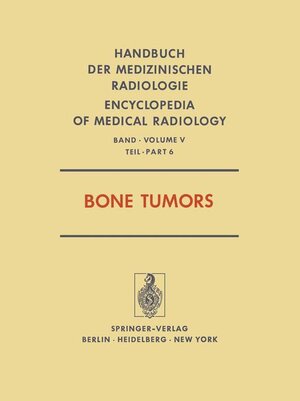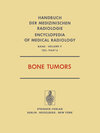
×
![Buchcover ISBN 9783540083122]()
Inhaltsverzeichnis
- Diagnosis, Classification, and Nomenclature of Bone Tumors..
- A. Introduction.
- B. Diagnosis of Bone Tumors.
- C. Radiologic Examination.
- D. Pathologic Examination.
- I. Surgical Biopsy.
- II. Needle or Aspiration Biopsy.
- E. Value and Limitations of Histochemistry in the Study of Bone Tumors.
- F. Electron Microscopy.
- G. Classification and Nomenclature of Bone Tumors.
- H. Histological Typing of Primary Bone Tumors and Tumorlike Lesions (WHO).
- References.
- Radiologie Approach to Bone Tumors..
- A. Location.
- B. Cortex.
- C. The Periosteum.
- D. Destruction of Bone.
- E. Margination or Zone of Transition.
- F. Increase in Bone Density.
- G. Matrix Calcification.
- H. Expansion of the Cortex.
- I. Trabeculation.
- J. Size.
- K. Shape.
- L. The Joint Space.
- M. The Age of the Patient.
- N. The Incidence of the Various Tumors.
- References see page 67.
- General Concepts and Pathology of Tumors of Osseous Origin..
- I. Osteoma.
- II. Osteoid Osteoma.
- III. Benign Osteoblastoma.
- IV. Osteogenic Sarcoma or Osteosarcoma.
- A. Benign Tumors of Osseous Origin.
- III. Osteoblastoma.
- B. Malignant Tumors of Osseous Origin.
- I. Osteogenic Sarcoma (Osteosarcoma, Central Osteosarcoma).
- II. Primary Multicentric Osteogenic Sarcoma.
- III. Osteogenic Sarcoma Developing in Abnormal Bone.
- IV. Osteogenic Sarcoma as a Complication of Paget’s Disease.
- V. Osteogenic Sarcoma Arising in Previously Irradiated Bone.
- VI. Osteogenic Sarcoma Associated with Fibrous Dysplasia.
- VII. Osteogenic Sarcoma in Osteogenesis Imperfecta.
- VIII. Soft Tissue Osteogenic Sarcoma.
- Parosteal Osteosarcoma..
- A. Clinical Features.
- I. Age and Sex.
- II. Localization.
- III. Symptoms.
- IV. Roentgenographic Features.
- V. Angiographic Features.
- VI. Differential Diagnosis.
- VII. Histopathological Features.
- B. Treatment.
- Cartilaginous Tumors and Cartilage-Forming Tumor-like Conditions of the Bones and Soft Tissues..
- B. Solitary Osteochondroma.
- I. Pathogenesis.
- II. Site.
- III. Clinical.
- IV. Roentgen.
- V. Histology.
- 1. Gross.
- 2. Microscopic.
- C. Radiation-Induced Osteochondromas.
- D. Multiple Osteochondromatosis.
- I. Clinical.
- II. Roentgen Features.
- III. Course.
- E. Solitary Enchondromas.
- III. Clinical Features.
- IV. Roentgen Features.
- V. Differential Diagnosis.
- VI. Histology.
- VII. Treatment and Course.
- F. Multiple Enchondromatosis.
- II. Clinical.
- III. Roentgen Features.
- IV. Histology.
- G. Dysplasia Epiphysealis Hemimelica.
- VI. Course.
- H. Juxtacortical (periosteal) Chondroma.
- II. Roentgen.
- III. Differential Diagnosis.
- V. Course.
- I. Chondroblastoma.
- II. Prevalence and Site.
- III. Age and Sex Distribution.
- IV. Symptoms.
- V. Roentgen Findings in Chondroblastoma.
- VII. Pathologic Findings.
- 1. Gross Features.
- 3. Electron Microscopic Findings.
- VIII. Treatment and Results.
- J. Chondromyxoid Fibroma.
- II. Clinical Features.
- III. Sites of Localization.
- VI. Pathologic Findings.
- VII. Treatment, Recurrence, Malignant Transformation.
- K. Chondrosarcoma.
- I. Incidence.
- II. Age and Sex.
- IV. Sites.
- V. Roentgenographic Features.
- L. Peripheral Chondrosarcoma.
- I. Histologic Criteria.
- II. Clinical Course.
- M. Mesenchymal Chondrosarcoma.
- II. Course.
- III. Histology.
- N. Dedifferentiation of Chondrosarcoma.
- II. Pathology.
- 1. Microscopic.
- III. Roentgen.
- IV. Course.
- O. Extraskeletal Cartilage Tumors of the Soft Tissues.
- I. Malignant Soft Tissue Cartilage Tumors.
- IV. Treatment and Prognosis.
- V. Benign Soft Tissue Cartilage Tumors.
- VI. Pathogenesis.
- VII. Clinical.
- VIII. Site.
- IX. Pathology.
- X. Roentgen.
- P. Synovial Chondromatosis.
- V. Synovial Chondrosarcoma.
- Q. Summary.
- Giant Cell Tumor of Bone..
- B. Pathologic Features.
- C. Roentgenographic Features.
- D. Treatment and Prognosis.
- Marrow Tumors..
- A. Ewing’s Sarcoma.
- I. Introduction.
- II. Incidence.
- III. Age.
- IV. Sex Incidence.
- V. Bones Involved.
- VI. Clinical Presentation.
- VII. Laboratory Data.
- VIII. Radiologic Features.
- 1. Periosteal Reaction.
- a) Onion-Skin Pattern of Subperiosteal Bone Formation.
- b) Right-Angled Spiculation (Sunray Appearance).
- c) Codman’s triangle.
- 2. Destruction of Bone.
- 3. Reactive New Bone Formation.
- 4. Soft-tissue Swelling.
- 5. Pathologic Fractures.
- 6. Other Appearances.
- 1. Gross •.
- X. Treatment.
- XI. Prognosis.
- XII. Differential Diagnosis.
- B. Reticulum Cell Sarcoma of Bone.
- II. History.
- III. Incidence.
- IV. Age.
- V. Sex Incidence.
- VI. Bones Involved.
- VII. Clinically.
- VIII. Laboratory Data.
- IX. Radiologic Features.
- 1. Location of Tumor in Bone.
- 2. Destruction of Cancellous Bone.
- 3. Destruction of Cortical Bone.
- 4. Reactive Proliferation of Bone.
- 5. Cortical Thickening.
- 6. Periosteal Reaction.
- 7. Soft-Tissue Involvement.
- 8. Pathologic Fracture.
- X. Pathology.
- XI. Treatment.
- XII. 5-Year Survival Rate.
- XIII. Metastases.
- XIV. Differential Diagnosis.
- C. Multiple Myeloma and Solitary Plasmacytoma.
- I. Incidence and Pathogenesis.
- II. Age.
- III. Sex.
- IV. Bones Involved.
- V. Clinical and Laboratory Data.
- VI. Diagnosis and Classification.
- VII. Radiologic Features.
- 1. Destructive Osteoclastic Lesions.
- a) Sharply Defined “Punched Out” Lesions.
- b) Expansile Lytic Areas.
- c) Generalized Osteoporosis.
- d) Pathologic Fractures.
- 2. Mixed Osteolytic and Osteoblastic Lesions.
- 3. Purely Osteoblastic Lesions.
- 4. Other Radiologie Features.
- VIII. Pathology.
- IX. Treatment.
- X. Prognosis.
- 1. Renal Disease in Multiple Myeloma.
- 2. Amyloid.
- XI. Differential Diagnosis.
- D. Lymphoma of Bone.
- IV. Sex.
- VIII. Radiologie Features.
- 1. Lymphosarcoma.
- 2. Hodgkin’s Disease.
- IX. Pathologic Features.
- Vascular Tumors of Bone..
- A. Hemangiomas.
- Roentgenographic Appearance.
- I. Diffuse Skeletal Hemangiomatosis.
- II. Massive Osteolysis.
- B. Lymphangioma.
- C. Glomus Tumor.
- D. Hemangiopericytoma.
- E. Hemangioendothelioma (Angiosarcoma).
- Connective Tissue Tumors of Bone..
- A. Chondrogenic Series.
- B. Fibrogenic Series.
- C. Fibrosarcoma.
- D. Lipoma.
- E. Liposarcoma.
- Chordoma..
- B. Embryology.
- I. General Considerations.
- II. Formation of Notochord.
- III. Origin of Notochord.
- IV. Chordal Ectopia and Chordal Remnants.
- 1. Ecchordosis Physaliphora.
- 2. Other Notochordal Remnants.
- 3. Relationship of Notochordal Remnants to Chordoma.
- C. Pathology.
- I. Gross Pathology.
- 1. General Considerations.
- 2. Classification of Chordoma.
- 3. Topographic Distribution of Chordoma.
- 4. Gross Pathology of the Intracranial Chordomas.
- 5. Gross Pathology of Nasopharyngeal Chordomas.
- 6. Gross Pathology of Vertebral Chordomas.
- 7. Gross Pathology of Sacrococcygeal Chordomas.
- 8. Histology of Chordoma.
- a) Histogenesis.
- b) Cytology.
- 9. Metastasis.
- 10. Chordoma in Unusual Locations.
- D. Clinical Findings.
- 1. Age and Sex.
- 2. Symptomatology.
- a) Clinical Findings in Intracranial Chordomas.
- b) Clinical Findings in Nasopharyngeal Chordoma.
- c) Clinical Findings in Vertebral Chordoma.
- d) Clinical Findings in Sacrococcygeal Chordoma.
- E. Roentgenologic Findings.
- I. Intracranial Chordomas.
- 1. Plain Film Findings (Including Body-Section Radiography).
- 2. Calcifications.
- 3. Angiography.
- a) Carotid Angiography.
- b) Vertebral Angiography.
- 4. Pneumoencephalography.
- 5. Brain Scan (Technetium 99m pertechnetate).
- 6. Computerized Tomographic (CT) Scan.
- II. Nasopharyngeal Chordomas.
- III. Vertebral Chordomas.
- 1. Plain Film Findings.
- 2. Myelography.
- IV. Sacrococcygeal Chordoma.
- V. Diagnosis.
- VI. Treatment.
- Adamantinoma (Malignant Angioblastoma), Schwannoma (Neurilemmoma), Neurofibroma..
- A. Adamantinoma Long Bones and Ameloblastoma — Jaw.
- I. Nomenclature.
- III. Pathology.
- IV. Roentgenology.
- V. Treatment.
- B. Schwannoma (Neurilemmoma).
- C. Neurofibroma.
- Tumor-like Lesions..
- A. The Solitary Bone Cyst.
- IV. Pathology.
- V. Pathogenesis.
- VI. Roentgenology.
- VII. Differential Diagnosis.
- VIII. Treatment and Prognosis.
- B. Aneurysmal Bone Cyst.
- C. Juxta-Articular Bone Cyst (Intraosseous Ganglia).
- II. Etiology.
- V. Roentgen Appearance.
- D. The Fibrous Cortical Defect or Nonosteogenic Fibroma.
- III. Clinical Manifestations.
- 1. Laboratory Findings.
- 2. Other Clinical Findings.
- IV. Location and Bilaterality.
- VI. Pathology.
- VII. Roentgenology.
- VIII. Roentgenologic Course and Prognosis.
- IX. Differential Diagnosis.
- E. Eosinophilic Granuloma.
- IV. Pathogenesis.
- V. Radiographic Findings.
- 1. Skull.
- 2. Mandible.
- 3. Spine.
- 4. Long and Flat Bones.
- VIII. Treatment and Course.
- F. Fibrous Dysplasia.
- 1. Monostotic Fibrous Dysplasia.
- 2. Polyostotic Fibrous Dysplasia and Albright Syndrome.
- 3. Associated Disorders.
- 4. Malignant Transformation.
- V. Etiology.
- VIII. Treatment.
- G. Myositis Ossificans.
- 1. Other Terms.
- 2. Etiology.
- 3. Clinical.
- 4. Pathology.
- 5. Roentgen Appearance.
- 6. Treatment.
- II. Myositis Ossificans Progressiva.
- H. Brown Tumors of Hyperparathyroidism.
- III. Etiology.
- 1. Primary Hyperparathyroidism.
- 2. Secondary Hyperparathyroidism.
- IV. Clinical.
- V. Pathology.
- VI. Roentgen Findings.
- Metastatic Bone Disease..
- A. Incidence.
- B. Localization.
- C. Method of Diagnosis.
- I. Clinical Evaluation.
- II. Roentgenographic Examination.
- III. Bone Scanning.
- D. Mechanisms of Metastasis.
- E. Roentgenographic Diagnosis.
- I. Patterns of Destruction.
- II. Osteolytic Metastases.
- III. Osteoblastic Metastases.
- IV. Periosteal New Bone Formation.
- V. Roentgenographic Characteristics.
- VI. Spinal Metastases.
- VII. Rib Metastases.
- VIII. Skull Metastases.
- IX. Peripheral Metastases.
- X. Metastatic Disease in Children.
- Conclusion.
- Study of Bone Tumors with Radionuclides..
- A. Radionuclides.
- I. Isotopes of Calcium.
- II. Isotopes of Strontium.
- III. Fluorine-18.
- IV. Miscellaneous Radionuclides.
- V. 99mTc Labeled Phosphate Compounds.
- VI. Bone Marrow Imaging Agents.
- B. Instrumentation.
- C. Mechanisms of Localization.
- D. Indications for Radionuclide Imaging of the Skeleton.
- E. Malignant Tumors.
- I. Osteosarcoma.
- II. Malignant Tumors of Cartilaginous Origin.
- III. Malignant Tumors of Vascular and Connective Tissue Origin.
- IV. Malignant Tumors of Marrow Origin.
- 1. Ewing’s Sarcoma.
- 2. Myeloma.
- 3. Leukemia.
- 4. Lymphoma.
- F. Benign Tumors and Tumorlike Abnormalities.
- 1. Osteoid Osteoma and Osteoblastoma.
- 2. Chondroma.
- 3. Giant Cell Tumor.
- 4. Aneurysmal Bone Cyst.
- 5. Fibrous Dysplasia.
- 6. Paget’s Disease.
- 7. Eosinophilic Granuloma.
- 8. Miscellaneous Lesions.
- G. Conclusion.
- Angiography of Bone Tumors..
- B. Vascular Anatomy.
- I. Nutrient Arteries.
- II. Periosteal and Perichondral Arteries.
- III. Metaphyseal and Epiphyseal Arteries.
- IV. Arterial Supply of Bone Lesions.
- C. Arteriography.
- I. Technique.
- II. Pharmacoangiography.
- III. Subtraction.
- IV. Complications.
- V. General Roentgenographic Findings.
- D. Bone-Forming Tumors.
- IV. Osteosarcoma.
- V. Parosteal Osteosarcoma (Juxtacortical Osteosarcoma).
- E. Cartilage-Forming Tumors.
- I. Chondroma.
- II. Osteochondroma.
- III. Chondromyxoid Fibroma ..
- IV. Benign Chondroblastoma.
- V. Chondrosarcoma.
- VI. Mesenchymal Chondrosarcoma.
- F. Giant Cell Tumor and Aneurysmal Bone Cyst.
- G. Vascular Tumors.
- I. Hemangioma.
- II. Lymphangioma.
- III. Hemangiopericytoma.
- H. Other Connective Tissue Tumors.
- I. Lipoma.
- II. Desmoplastic Fibroma.
- III. Fibrosarcoma.
- IV. Liposarcoma.
- I. Marrow Tumors.
- I. Ewing’s Sarcoma and Reticulum Cell Sarcoma.
- II. Myeloma.
- J. Other Tumors.
- I. Chordoma.
- II. Adamantinoma of Long Bone.
- III. Neurolemmoma (Schwannoma, Neuronoma).
- K. Tumorlike Lesions.
- I. Metaphyseal Fibrous Defect (Nonossifying Fibroma).
- II. Fibrous Dysplasia.
- III. Myositis Ossifìcans.
- L. Metastatic Bone Lesions.
- I. Osteolytic Metastasis.
- II. Osteoblastic Metastasis.
- High-Resolution Radiographic Techniques for the Detection and Study of Skeletal Neoplasms..
- A. Radiographic Techniques.
- B. Comparison of Images Using Magnification Techniques.
- I. Optical Magnification.
- II. Optical Vs. Radiographic Magnification.
- III. Radiographic Magnification.
- Summary and Conclusions.
- Author Index — Namenverzeichnis.




